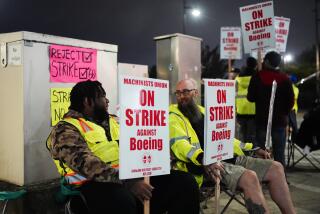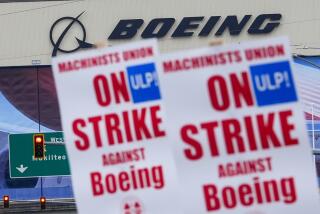Pan Am, Unions Near Accord on Cuts; Some Executives Face Ouster
- Share via
NEW YORK — Pan Am Corp., parent company of the nation’s eighth-largest airline, said Tuesday that it expects union agreement soon on a package of wage and benefit cuts and that it will replace some top executives if the plan is approved.
The announcement appeared to be a victory for the airline’s unions, which have refused to grant the company deep contract concessions while Chairman C. Edward Acker remains in charge. If a final agreement on a concessions package is reached, Pan Am could again pull back from the brink of bankruptcy that it has edged near numerous times in recent years.
The airline holding company’s stock closed up 12.5 cents Tuesday at $3.125 a share in trading on the New York Stock Exchange.
The company did not specify the size of the concessions package it expects to obtain from the unions, but it is believed to total at least $200 million a year in wage and benefit concessions. Pan Am said in its statement that it was told by a union representative that “an agreement on a package of labor concessions requested by the company would be forthcoming in the near future.”
Outside Buyer
Pan Am also said that “it intended to make changes in senior management of the company following a final labor settlement.” The company refused to say who in management would be replaced, but industry analysts have said that Pan Am is likely to replace Acker, who has been considered a major impediment to any union agreement.
A union source said earlier Tuesday that either Acker or Vice Chairman Martin Shugrue was liable to be ousted by the board.
Candidates to head Pan Am were reported by union sources to include William Howard, former head of Piedmont Airlines; Tom Plaskett, a former executive at American Airlines who last year joined and left Continental Airlines, and John Zeeman, an executive at United Airlines who was recently passed over for the top spot at that carrier.
The unions have been looking for an outside buyer for the airline and have been willing to grant wage, benefit and work rule concessions of at least $180 million a year in return for new management. The airline badly needs lower labor costs to survive, having lost more than $1 billion this decade.
The most recent possible investor was Jay Pritzker, who controls Braniff Inc. and last month had a tentative deal to merge that carrier with Pan American. The deal failed after Pritzker could not obtain concessions of $200 million a year from the unions and the two companies could not reach final agreement on details of how to accomplish the merger.
Stumbling Block
However, before Pan Am’s statement was released in New York, Braniff Vice Chairman Patrick Foley said in Dallas that negotiations between Braniff and Pan Am’s unions had been renewed. He said the pilots union, considered to be the key labor group at Pan Am, may be reconsidering Braniff’s offer.
Pan Am said the package of labor concessions it now expects to receive would come from a coalition of four of its five largest unions: the Air Line Pilots Assn., the Independent Union of Flight Attendants, the Teamsters, which represents sales and reservations agents, and the Flight Engineers International Assn. The International Assn. of Machinists, which represents mechanics and ground crews, is not a member of the group.
The company said the concessions would be subject to ratification by union membership and would be effective for three years.
Airline analyst Louis Marckesano of Janney Montgomery Scott in Philadelphia has called Acker a stumbling block in reaching a labor agreement because of long animosity between him and the labor groups. Acker, who joined Pan Am as chairman in 1981, has been accused by unions and some analysts of mismanaging the company.
Pan Am has recently cut its losses sharply. After losing $463 million in 1986, it lost just $19.8 million in the first nine months of 1987. However, with a heavy dependence on vacation travelers to Europe, Pan Am usually posts losses in the winter. Analysts also noted that the company must make payments on $950 million in debt.
More to Read
Inside the business of entertainment
The Wide Shot brings you news, analysis and insights on everything from streaming wars to production — and what it all means for the future.
You may occasionally receive promotional content from the Los Angeles Times.










